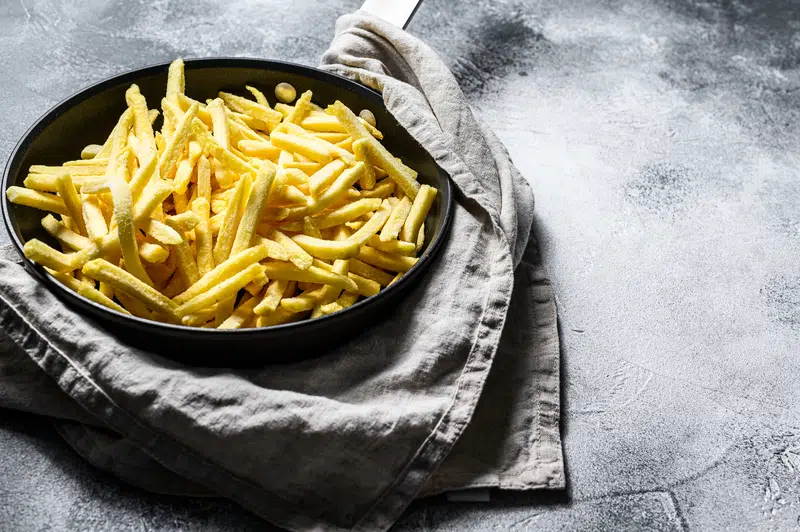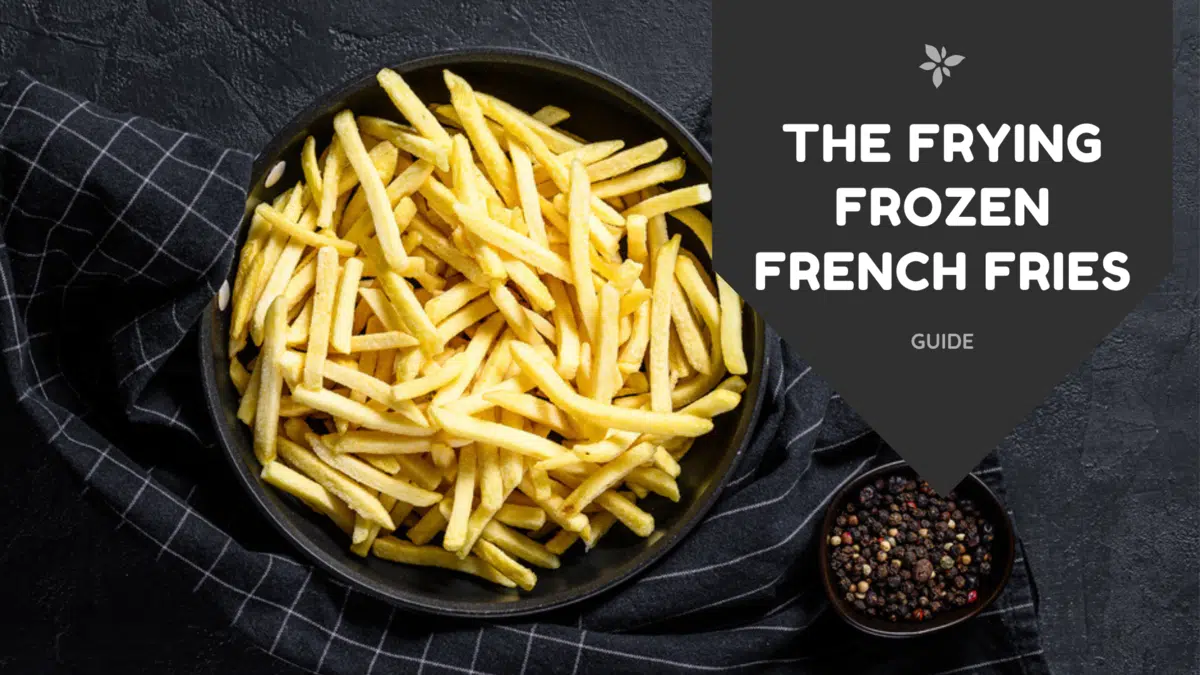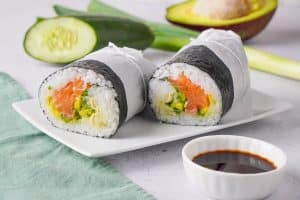The Frying Frozen French Fries In Your Pan Guide
Important Note: When you buy through our links, we may earn a commission. As an Amazon Associate we earn from qualifying purchases. Content, pricing, offers and availability are subject to change at any time - more info.
We all have a soft spot for perfectly golden, crispy on the outside, and soft on the inside French fries! However, life gets busy, and making French fries from scratch is too time-consuming, so we opt for the frozen, store-bought option instead. So, how can we prepare Frozen fries to have the same crispy yet soft texture as the fresh ones?
Fry frozen French fries in a skillet pan using a neutral-tasting oil with a high smoke point. In addition, ensure to heat the oil to 350°F and fry the French fries for 3-5 minutes or until golden-brown and crispy. Avoid adding too many fries to the pan to ensure even cooking.
French fries are a delicious side dish or quick snack paired with a yummy sauce; we consider them a staple in many homes. So we are here to offer you a hand in the kitchen by explaining exactly how to cook these fellows in a pan.
- Frying Frozen French Fries In A Pan
- Should You Double Fry Frozen French Fries?
- Should I Defrost Frozen French Fries Before Pan-Frying Them?
- Oil Best For Pan-Frying Frozen French Fries
- Can You Pan-Fry Frozen French Fries In Animal Fat?
- Can You Use Butter To Pan-Fry Frozen French Fries?
- How To Make Pan-Fried Frozen French Fries Tastier?
- Frying Frozen French Fries In Your Pan Guide
Frying Frozen French Fries In A Pan

Whether you get back from work late or do not feel like the tedious process of making homemade fries, opting for frozen French fries saves you all the preparations of peeling, slicing, washing, and double-frying.
While there are various ways to prepare frozen French fries, pan-frying fries is the most efficient and straightforward method to attain delicious, crispy golden-brown fries.
All calories aside, you’re sure to get a tastier French fry by frying frozen fries compared to baking them.
You’ll want to use a skillet — a frying pan with a more extended handle. A skillet will come in handy as it prevents piping hot oil from splashing on you. In addition, a skillet allows you to easily regulate the duration of frying the frozen French fries while altering the heat of the stovetop as needed.
It is preferable to use a wok pan or cast-iron skillet to accommodate enough oil necessary for frying the frozen French fries. In addition, stainless steel or non-stick ceramic pan will ensure that the skillet has uniform heat distribution.
In comparison, popping the frozen French fries into the oven is somewhat more challenging to control as you cannot lower the heat as fast in the oven as on a stovetop.
To achieve yummy golden potato sticks, you can either deep-fry, shallow-fry, or sauté the frozen French fries.
Here’s how:
Deep-Frying
While you cannot truly deep fry your frozen French fries in a pan, you can come pretty close!
- First, be sure to use a deeper pan or skillet to ensure that it is deep enough to hold enough oil for deeper frying.
- Next, add approximately three to four inches of oil to your pan and preheat it over medium to high heat. Ensure to heat the oil to around 350°F before adding the fries to the pan.
- You’ll want to wait until you notice a faint shimmer and smoke rising from the oil.
- Then, carefully drop one French fry into the oil. Is it simmering? If yes, then add the extra fries to the oil. However, avoid adding too many fries at one time; instead, split the portions into two.
- Now, wait for the French fries to reach a perfect golden-brown color and crispy texture.
- Use a slotted spoon to remove your fries from the oil. Be sure to shake off the excess oil or place the French fries into a strainer or onto a paper towel to drain or soak up most of the fat residue.
- Lastly, while waiting for the fries to cool down slightly, add your favorite spice or sauce to the crispy French fries and enjoy!
Shallow-Frying
Shallow-frying is similar to deep-frying frozen French fries; however, you do not need to use a deep pan; you can use a regular skillet. In addition, shallow-frying is the most common method of frying frozen French fries at home.
- Start by adding oil to the skillet and heating it at a depth of ¼ inch in the bottom of your pan over medium to high heat.
- Heat the oil to around 350°F or as soon as you notice smoke rising from the glistening hot oil, carefully add a large handful of the frozen French fries to the oil. Like deep-frying chips, you’ll want to avoid adding too many fries at once.
- Then, cook the French fries until they reach your desired amount of crispiness.
- Consider covering the skillet with a splatter shield to reduce the mess you’ll need to clean up afterward.
- Take a slotted spoon or spatula and remove the fries from the oil. Be sure to keep the fries over the pan, allowing most of the oil to drain before moving the fries away.
- Now, place the golden-brown French fries on a paper towel to remove most of the oil or fat residue. More so, if you run out of paper towels, place the fries onto a wire rack to remove the excess oil.
- Lastly, wait around five minutes for the fries to cool down slightly. While waiting, apply salt and pepper or your favorite seasoning and spice to the yummy French fries and dive right in!
Pro Tip: If the frozen French fries have freezer burn, consider allowing the frozen French fries to sit out for ten minutes before frying them; allowing most of the ice on the frozen fries to evaporate will minimize the oil splattering. However, please DO NOT allow the fries to thaw as they’ll turn soggy.
Sautéing
For a healthier option, or if you don’t have enough oil on hand, you can still achieve a deliciously golden French fry while using less oil. Sautéing frozen French fries is similar to pan-frying regular potatoes.
- Take a large non-stick pan a pour a tiny amount of oil into the pan — as you would while sautéing other foods. Note that if you do not have oil, you can also use clarified butter.
- Once the pan is hot, add the frozen French fires onto the pan in a single layer. If your pan isn’t large enough, fry the French fries in multiple batches rather than crowding them. Again, a single layer of fries will ensure that they even turn brown and crispy.
- Consider covering the fries with a splatter shield to minimize the oil splatter. However, avoid using a lid as the French fries are pre-cooked, and placing a top on the pan will only make them go soggy.
- You can season the fries while waiting for the bottom side to turn golden and crispy.
- Fry your French fries undisturbed for four to five minutes. Then, flip the fried to brown the other side; continue this process until all the sides of the fries are golden-brown. Note that turning the fries too soon will often break them or make the fries go soggy.
Should You Double Fry Frozen French Fries?
Contrary to traditional homemade fries made from fresh, raw potatoes, it is not required to double fry store-bought, frozen French fries.
While you can double fry the frozen French fries to attain a crispier texture, most store-bought frozen fries are already pre-fried.
Should I Defrost Frozen French Fries Before Pan-Frying Them?
Many folks wonder if it’s necessary to defrost the frozen French fries before popping them into the oven or pan of oil.
French fries are a type of food that does not require thawing before you cook them; you do not have to hesitate to shove the fries into the skillet straight from the freezer.
You can let the frozen French fries sit out on the counter for around ten minutes before frying them to get rid of the clumps of freezer burn that will cause the hot oil to splatter. However, avoid allowing the French fries to thaw completely, as the additional moisture will make the fries soggy.
Note that it is safe to fry thawed fries. While the taste and quality will decline, they aren’t “bad” and are still edible. In addition, ensure to keep a close eye on frying thawed French fries as they’ll cook faster than fries directly out of the freezer.
If you keep the French frozen until you are ready to fry them, it will ensure that the fries’ surface stays sealed, ensuring a crispier golden fry.
Oil Best For Pan-Frying Frozen French Fries
Ideally, we are looking for an oil variety with a high smoke point and a neutral taste.
The top five oils for frying French fries are the following:
- Peanut oil
- Canola oil
- Vegetable oil
- Safflower oil
- Grapeseed oil
The five oils mentioned above have a smoke point well beyond 350°F.
While other oil varieties, like corn, coconut, or sesame, also exhibit smoke points beyond 350°F, these oils tend to impart a lot of flavor into your product that can be undesirable for many individuals.
Sunflower oil eliminates a strong, pungent odor when heating it at a suitable temperature for frying French fries. More so, sunflower oil affects the natural flavor of French fries.
Then, olive oil or other unrefined oils have a low smoke point, making them unsuitable for frying. Frying French fries in olive oil will cause the oil to burn before it can hit the desired temperature to ensure you achieve a golden-brown fry.
Can You Pan-Fry Frozen French Fries In Animal Fat?
You can fry your frozen French fries in animal fat. More so, animal fat is practical, and it imparts a degree of flavor into the French fries.
Consider using beef tallow, duck fat, chicken schmaltz, or lard.
Can You Use Butter To Pan-Fry Frozen French Fries?
It is best not to use natural butter to fry frozen French fries in a pan as butter cannot sustain the heat requirement for frying; the butter will most like start to smoke and burn.
However, if you desire a buttery taste, you can use clarifying butter to remove all the milk solids. Clarifying the butter first ensures that it is suitable for high heat.
How To Make Pan-Fried Frozen French Fries Tastier?

Frozen French fires never have to be basic! While you can stick to the standard method of sprinkling salt and pepper onto your fries, we encourage you to get creative and to try the spicy route!
Consider elevating your French fries by adding a splash of flavor and color to this popular side dish. Here are our favorite seasoning ideas that will take your fries from bland to gourmet:
Pair Frozen French Fries With Acidic Ingredients
Pairing your French fries with acidic ingredients will immediately enhance the natural potato flavor.
Try using toppings like vinegar, citrus juice, hot sauce, or pickles to add a contrasting flavor to the richness of your crispy French fries.
Note that you’ll want to avoid using too many acidic liquids as the moisture can cause the French fries to go soft and mushy. So, all you need is a light spritz as soon as you remove the fries from the pan.
With Seasoning
Add a gourmet flair to your French fries by sprinkling fresh herbs and seasoning over them once you remove them from the pan.
Yummy spices that pair well with French fries include
- Garlic Powder
- Paprika
- Cayenne Pepper
- Fresh Rosemary
- Oregano
- Seasoned Salt
With A Drizzle Of Oil
Much like fresh herbs and spice, oils add a delicious flavor to French fries that immediately “up your game” at dinner time.
Consider drizzling fresh virgin-olive oil or truffle oil onto your fries once you remove them from the pan. Be sure only to use a small amount; drenching the fries in oil can cause the fries to turn soggy, and the taste can be overpowering.
Frying Frozen French Fries In Your Pan Guide
If you’re not feeling up to it to spend most of your evening peeling and cutting potatoes for fries, grab the bag of store-bought frozen French fries and pop them into a sizzling hot pan with oil.
Be sure to use a neutral-tasting oil with a high smoke point and follow the recommended steps mentioned above to ensure that you have perfectly cooked, crispy, and golden-brown French fries.
Lastly, switch off your calorie-conscious mind and enjoy the bag of mouth-watering fries!























